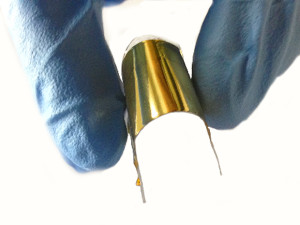
Using human skin as one of its charge-collectors, a new flexible generator converts muscle movements into enough power for small electronics.
Image: National University of Singapore
A new discovery from the National University of Singapore has yielded a material that could be used to create battery-free, wearable sensors to power your electronics from the energy generated via muscle movement.
The sensor, which is the size of a postage stamp, uses human skin as one of its charge-collectors. The device takes advantage of static electricity to convert mechanical energy into electricity. It is powered by the wear’s daily activities such as walking, talking, or simply holding an object.
This from IEEE Spectrum:
They tested the device by attaching it to a subject’s forearm or throat, nanopillar side down. Fist-clenching and speaking produced 7.3V and 7.5V respectively. The researchers tested the device as a human motion/activity sensor by attaching it on the forearm and measuring the pulse generated due to holding and releasing of an object.
Tapping the device generated the highest voltage of 90V and power of 0.8mW. This could light up twelve commercial LEDs.
The whole thing works due to the phenomenon known as the triboelectric effect, which creates a potential difference when two materials are pulled apart or flexed. Current then flows between the two materials (i.e. the skin and the sensor), which can be collected using an electrode.
The researchers hope they can make more devices that can be integrated into wearable technology.
For more information on energy storage and conversion, make sure to attend our conference in Glasgow this July!
Abstract deadline for this conference is Feb. 20.
Submit today!
P.S. Don’t forget to meet the organizers.

